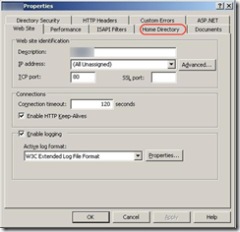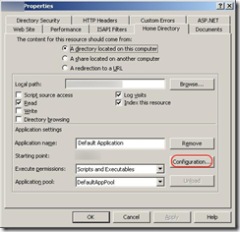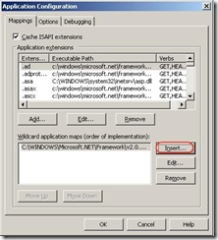If you happen to be running PHP on a Windows Server machine you’ll probably have to port over some functionality. One of the key things that you’ll have to port over is something that mimics the .htaccess functionality of prompting users for user/pass based upon the directory.
In your application you might have a directory that is for admin, such as www.myexample.com/admin. This directory might only be accessible to users that you want to specify. In a *NIX environment you can do this with an .htaccess file (and its corresponding .htpasswd) file. Unfortunately when porting this to a Windows environment, these files don’t do anything for you (unless you’re running Apache on Windows).
Solution
Here’s what you’ll need.
- a login page, login.aspx
- a web.config file
- ASP.NET 2.0 installed
- A minor adjustment to IIS 6
Steps
1. Install PHP.
2. Create a web.config with the following in it.
<?xml version="1.0"?> <configuration> <appSettings/> <connectionStrings/> <system.web> <compilation debug="true" /> <authentication mode="Forms"> <forms protection="All" loginUrl="~/login.aspx"> <credentials passwordFormat="Clear" > <user name="admin" password="abc123"/> <user name="jdoe" password="123xyz" /> </credentials> </forms> </authentication> </system.web> <location path="admin"> <system.web> <authorization> <deny users="?"/> <allow users="*"/> </authorization> </system.web> </location> </configuration>
2. Create a login page with a login control. In that code behind (or in the page itself as I’ve done) set up the Authenticate Event to use Forms Authentication. This will ensure that its reading from the web.config file and not the default membership provider (SqlMembershipProvider).
<%@ Page Language="C#" AutoEventWireup="true" %> <script runat="server"> protected void Page_Load(EventArgs e) { Page.SetFocus(loginControl); } protected void loginControl_Authenticate(object sender, AuthenticateEventArgs e) { if (FormsAuthentication.Authenticate(loginControl.UserName, loginControl.Password)) { FormsAuthentication.RedirectFromLoginPage(loginControl.UserName, false); } } </script> <!DOCTYPE html PUBLIC "-//W3C//DTD XHTML 1.0 Transitional//EN" "http://www.w3.org/TR/xhtml1/DTD/xhtml1-transitional.dtd"> <html xmlns="http://www.w3.org/1999/xhtml" > <head runat="server"> <title>Untitled Page</title> </head> <body> <form id="form1" runat="server"> <div> <asp:Login ID="loginControl" runat="server" DisplayRememberMe="False" OnAuthenticate="loginControl_Authenticate"> </asp:Login> </div> </form> </body> </html>
3. Now, remember, this site is a PHP site and it is being run with PHP. Therefore the first document that is being loaded is the index.php file. Therefore the ISAPI or CGI module for PHP Is being called before ASP.NET is ever initialized. Therefore, if we try to access the admin site, ASP.NET will NOT catch this and it will allow access. In order to get around this, we have to set the aspnet_isapi.dll module to execute first, therefore IIS will load ASP.NET which in turn will check the web.config file and not allow access to restricted directories.
Here’s how to do it.
3a. Start IIS Manager (start –> Run –> inetmgr) Open the sites properties. Click on “Home Directory”
(click for larger)
Once on the Home Directory tab, click on the Configuration button.
(click for larger)
Now click on “Insert” and enter the path to the aspnet_isapi.dll:
(%systemroot%/Microsoft.Net/Framework/v2.0.50727/aspnet_isapi.dll)
Then click OK, and it will look like this: (click for larger)
Restart IIS and then give your application a test.
Visit the Admin directory and now you should be redirected to the login page.
Log in with the admin credentials that are in the web.config you’ll then be authenticated.
What this does is force IIS to load ASP.NET first, regardless of what type of file is loaded. In this situation this is exactly what I want it to do. Load ASP.NET and run anything in the Web.config file. Therefore if the user attempts to load the /admin directory ASP.NET will notice that its a protected directory and it will deny access.
Adding a New Directory
If you want to add a new secured directory, you can add another <location> in the web.config.
Like so:
<?xml version="1.0"?> <configuration> <appSettings/> <connectionStrings/> <system.web> <compilation debug="true" /> <authentication mode="Forms"> <forms protection="All" loginUrl="~/login.aspx"> <credentials passwordFormat="Clear" > <user name="admin" password="abc123"/> <user name="jdoe" password="123xyz" /> </credentials> </forms> </authentication> </system.web> <location path="admin"> <system.web> <authorization> <deny users="?"/> <allow users="*"/> </authorization> </system.web> </location> <location path="secretfolder"> <system.web> <authorization> <deny users="?"/> <allow users="*"/> </authorization> </system.web> </location> </configuration>
Explanation
I’ve added a “secretfolder” location. Therefore, if a user wants to go to either the “admin” or “secretfolder” they will be authenticated. If they authenticate at the “admin” directory, they will automatically be allowed into the “secretfolder” directory.
You can set folder access to certain users, to learn how see this is accomplished, take a look at the great list of resources that ScottGu has set up .
Note, in IIS 7 this problem does not exist, but you do need to include this into your web.config to enable forms authentication. Here’s the source of this info.
<system.webServer> <modules> <remove name="FormsAuthenticationModule" /> <add name="FormsAuthenticationModule" type="System.Web.Security.FormsAuthenticationModule" /> <remove name="UrlAuthorization" /> <add name="UrlAuthorization" type="System.Web.Security.UrlAuthorizationModule" /> <remove name="DefaultAuthentication" /> <add name="DefaultAuthentication" type="System.Web.Security.DefaultAuthenticationModule" /> </modules> </system.webServer>
Hopefully this helps anyone doing the same thing.


